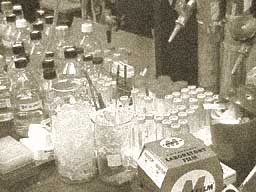|
|
 |
 |
PCR amplification of
fungal chitin synthase homologous sequences
M. Momany and P.J. Szaniszlo |
Index:
(to jump to a listing, click on the desired name to the right) |
Materials
Protocol
Results
Tips |
| |
Principle
and General Applications |
| |
The degenerate PCR primers and amplification
parameters described in this protocol have been used to amplify chitin synthase (CHS)
homologous sequences from many different fungi (Chen-Wu et al., 1992; Bowen et al., 1992).
In addition to allowing the identification and isolation of the CHS gene
themselves, CHS PCR homologues have been used in phylogenetic analysis. |
| |
(Back to
the top) |
| |
Materials |
| |
PCR primers: Degenerate CHS primers designed
by Chen-Wu et al. (1992)
| |
|
|
|
|
A |
|
|
|
|
|
| |
|
|
|
|
C |
|
|
|
|
|
| |
|
|
|
|
G |
C |
C |
A |
C |
|
| Primer 1: |
| 5' |
CTG |
AAG |
CTT |
ACT |
ATG |
TAT |
AAT |
GAG |
GAT |
3 |
| HindIII |
| |
|
|
|
C |
A |
C |
A |
A |
T |
|
|
Primer 2 |
| 5' |
GTT |
CTC |
GAG |
TTT |
GTA |
TTC |
GAA |
GTT |
CTG |
3 |
| XhoI |
0.5 ml centrifuge tubes
Taq DNA polymerase and 10x reaction buffer (supplied by
manufactuerer; generally contains: 0,1 M Tris-Cl, pH 8.3, 0.5 M KCl, 15 mM MgCl2,
and 0.01% gelatin)
dNTP mix - all four dNTPs at 1.25 mM each
Fungal DNA at 100 ng·ml-1 H2O
Light mineral oil (Sigma)
Thermocycler
1.2% agarose gel |
| |
(Back to
the top) |
| |
Protocol |
| |
- In a 0.5 ml microfuge tuber combine:
2.5 µl 10x manufacturer's reaction buffer.
4 µl dNTP mix (1.25 mM each dNTP)
2.5 µl primer mix (both primers at 1m each)
0.5 units Taq DNA polymerase.
1.25 to 2.5µl template DNA (100 ng·ml-1 H2O)
Add H2O to make total volume 25 µl
Layer a drop of light mineral oil on top of the reaction mix to prevent evaporation
- Amplify in thermocycler as follows:
Premelt: 94ºC for 5 min
29 Cycles: 94ºC for 1 min, 55ºC for 2 min; 72ºC for 3 min.
1 cycle: 94ºC for 1 min, 55ºC for 2 min; 72ºC for 10 min.
Chill to 4ºC to stop reaction
Depending on the thermocycler used, the amplification should be complete in 5-6 hours.
- View amplification products by electrophoresis in a 1.2%
agarose gel. (When taking products from the reaction tube be careful not to take along
mineral oil). 15 µl of the 25 µl reaction should contain enough DNA to be visible.
If you plan to clone the PCR product, you may load the whole 25 µl and excise the
band after electrophoresis. Just be sure your gel box is free of other DNA prior to
loading (wash it with 0.5 N HCl followed by 0.5 N NaOH and rinse well with H2O).
|
| |
(Back to
the top) |
| |
Results |
| |
You should be able to see a strong band of
about 600 bp (or somtimes larger if introns are involved) after electrophoresis. All
amplification products should be sequenced to verify that they are true CHS homologues and
not PCR artifacts. Amplification products should also be analyzed by genomic
hybridization to verify that they arose from the organism under investigation and not from
contamination. This is especially important in labs where amplified CHS genes from
many fungi are being investigated. |
| |
(Back to
the top) |
| |
Tips |
| |
DNA contamination is the major problem you must
guard against in this, or any, PCR protocol. Aliquot buffers, primers, and
polymerase. Record the aliquot number used for each reaction. Always run a
negative control reaction (no template DNA). If you get a band in the negative
control, then throw away the aliquots that were used. It wastes much less time than
trying to track down where the contamination is. Get pipet tips with built-in
filters. These really do help reduce the contamination from droplet transfer.
Always add your template to the reaction last. This minimizes your chances of
getting template into your reaction buffer, stocks, etc. Irradiation of the reaction mix before the addition of the template DNA and Taq
DNA polymerase is suggested to insure against amplification of unwanted contaminant DNA.
This can be achieved by placing the reaction tubes in an open bottom rack on a UV
transilluminator (Fotodyne Foto/prep I transilluminator) and exposing to UV for 5 min
(Sarkar and Sommer, 1990).
Resuspend DNA in H2O, not TE buffer. The
EDTA can inhibit amplification. Impurities carried over from DNA isolation may also
inhibit the amplification reaction. It is often possible to dilute out the
impurities. If you have trouble with a particular template try doing several
dilutions in H2O (1:100, 1:1,000 etc.). Another trick for helping
amplification from stubborn templates is the addition of 2% DMSO. |
| |
(Back to
the top) |
 |
This page updated on:
Monday, March 03, 2003 11:54:43 PM |
|
|
|
|